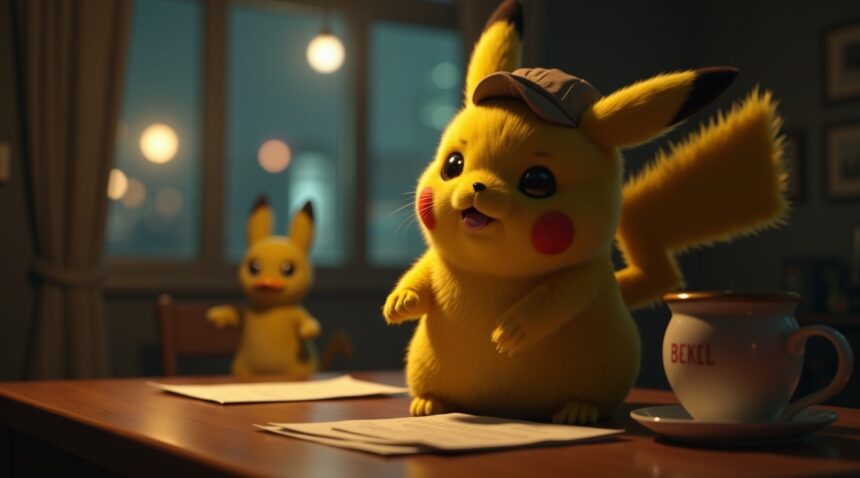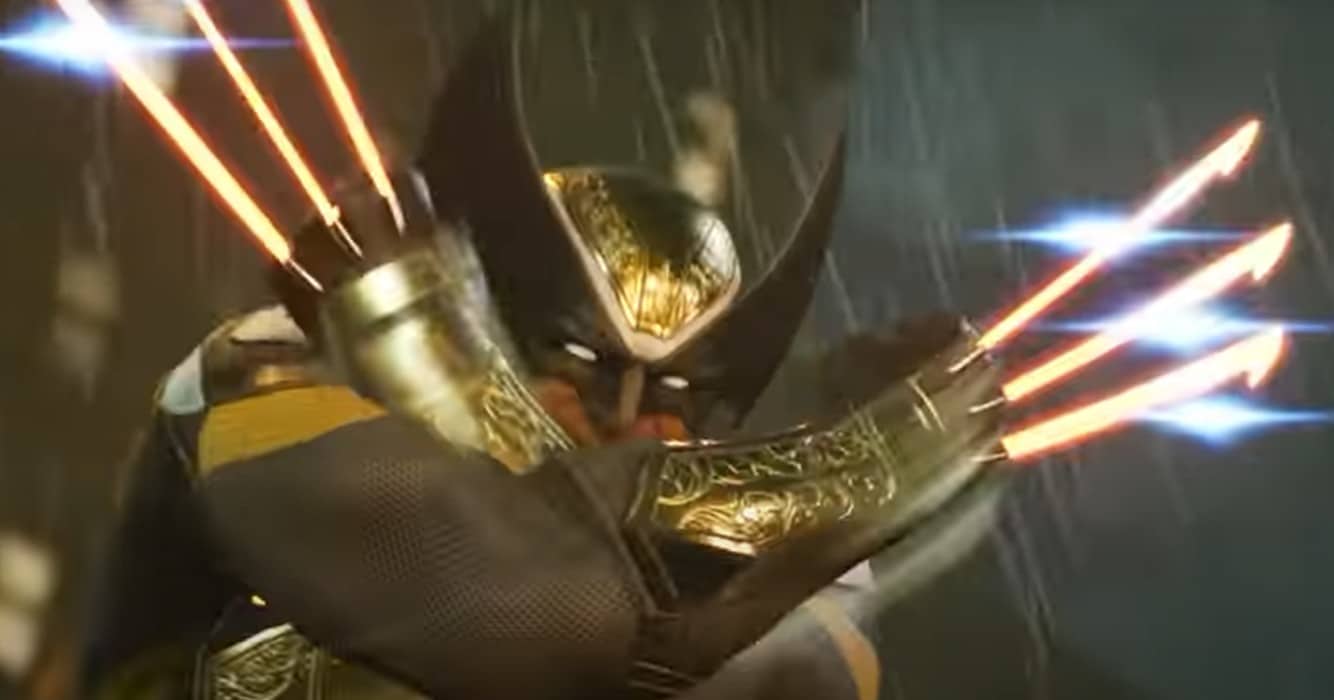Pokemon Detective Pikachu changed family entertainment forever in 2019.
The film achieved what many thought impossible by becoming the first successful live-action Pokémon adaptation, generating over $433 million globally. Revolutionary CGI techniques brought cherished animated creatures into reality with unprecedented success.
The production’s advanced approach to creature animation established new benchmarks for the industry. Motion capture technology and environmental integration worked together to transform 2D animated characters into convincing 3D beings. These digital creatures coexist naturally alongside human actors, creating a seamless viewing experience.
Key Takeaways
- Advanced CGI rendering techniques created realistic textures, fur, and facial expressions that made Pokémon appear genuinely lifelike while maintaining their iconic characteristics that fans recognized and loved.
- Ryan Reynolds’ motion capture performance as Detective Pikachu successfully translated human expressions and personality onto a Pokémon character, creating authentic emotional depth through sophisticated facial animation technology.
- Real-world animal texture studies combined with precise environmental lighting integration achieved “tactile believability,” making digital Pokémon feel like physical creatures viewers could reach out and touch.
- On-set puppet stand-ins and real location filming in London and Scotland bridged the gap between digital and physical production, giving actors tangible references and embedding Pokémon naturally within familiar human environments.
- Collaborative partnerships between major VFX studios and The Pokémon Company ensured brand-faithful results while pushing technical boundaries, setting new standards for future animated-to-live-action adaptations across the entertainment industry.
First Live-Action Pokemon Film Breaks Box Office Records and CGI Barriers
Pokemon Detective Pikachu arrived in theaters in 2019 as a groundbreaking achievement that transformed how audiences perceive animated creatures on screen. This first live-action and CGI hybrid film in the Pokemon franchise shattered expectations and financial records, earning over $433 million worldwide while establishing a new benchmark for CGI creatures in family entertainment.
The film’s remarkable success stemmed from its sophisticated approach to CGI animation techniques that made Pokemon appear genuinely lifelike. Advanced rendering technology brought texture and personality to each creature, from Pikachu’s fluffy fur to Psyduck’s realistic feathers. These visual innovations created an unprecedented level of believability that resonated with audiences across different age groups.
Bridging Nostalgia and Modern Realism
CGI technology in Detective Pikachu accomplished something remarkable — it satisfied both longtime Pokemon fans who grew up with the animated series and newcomers experiencing these creatures for the first time. The film’s artists carefully balanced maintaining the recognizable characteristics that fans loved while adding realistic details that made the Pokemon feel tangible and alive.
Ryan Reynolds’ voice acting as Detective Pikachu combined with motion capture technology created a character that felt authentic rather than artificial. This successful fusion of traditional animation aesthetics with cutting-edge CGI demonstrated how technology can honor source material while pushing creative boundaries forward.
Setting New Industry Standards
The influence of Detective Pikachu’s CGI approach extends far beyond the film itself. Game developers, commercial creators, and animators now reference the movie’s rendering techniques when designing Pokemon for various media platforms. The realistic fur simulation, facial expressions, and movement patterns established in the film have become the gold standard for Pokemon representation.
Subsequent projects have adopted similar advanced CGI methods, incorporating more sophisticated lighting effects and environmental interactions. Future Pokemon films continue building upon these technical foundations, pushing the boundaries of what’s possible with creature animation.
The film’s success also influenced merchandise design and marketing campaigns. Pokemon products now feature more realistic interpretations inspired by the movie’s visual style, while promotional materials increasingly utilize similar CGI techniques to maintain consistency across different platforms.
Studios producing family films have taken notice of Detective Pikachu’s approach to character design and animation. The film proved that audiences embrace realistic interpretations of beloved animated characters when the execution maintains respect for the original designs while enhancing their believability through technology.
This technical achievement opened doors for live-action Pokemon adaptations across different formats and platforms. The CGI standards established by Detective Pikachu continue influencing how creators approach the challenge of bringing animated characters into live-action environments, setting expectations for quality and authenticity that future projects must meet or exceed.
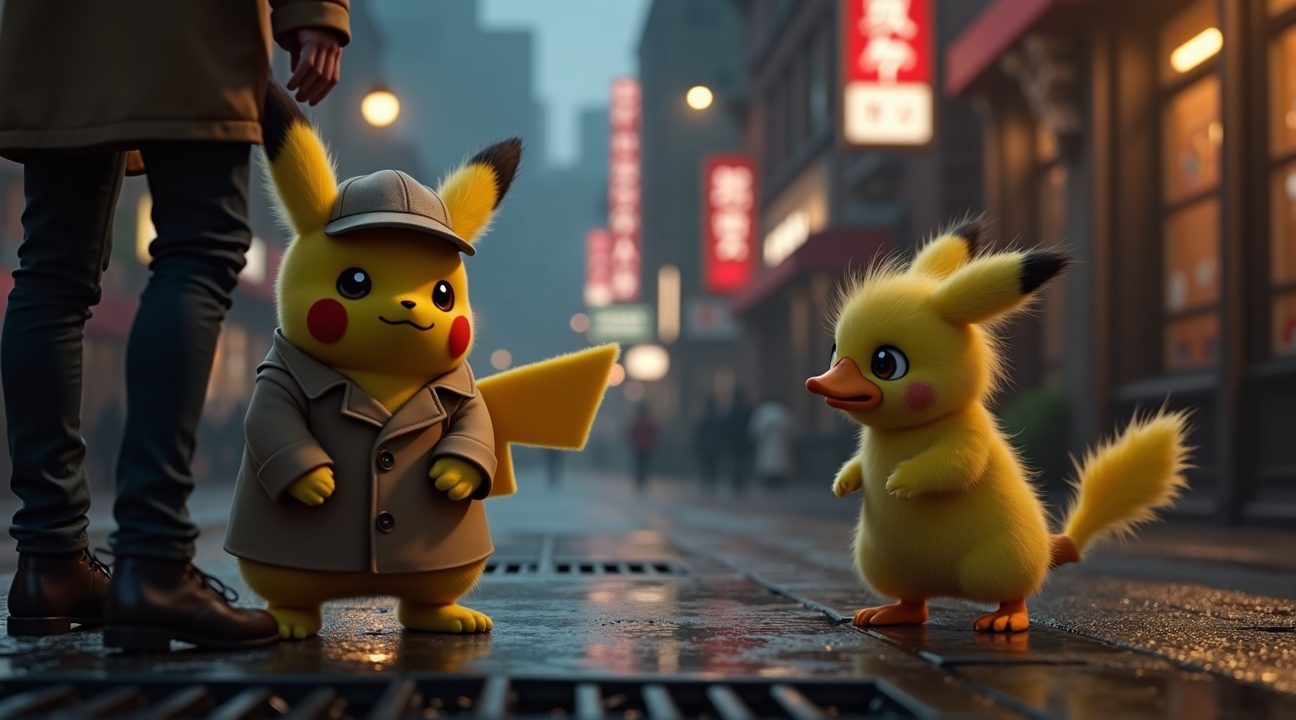
Transforming 2D Anime Characters into Believable 3D Creatures
The transition from flat, stylized anime designs to convincing three-dimensional beings presented one of the biggest creative challenges in bringing Pokemon to life. Iconic creatures like Pikachu possessed cartoonish proportions that looked perfectly natural in their 2D world but threatened to appear absurd when placed alongside human actors in live-action settings.
Balancing Authenticity with Physical Plausibility
Designers faced a delicate balancing act when reimagining these beloved characters. The creative teams worked closely with The Pokemon Company to ensure each transformation honored the original designs while incorporating real-world physics and anatomy. Several key considerations guided this process:
- Eyes needed to function believably while maintaining their characteristic expressiveness
- Body proportions required adjustment to support realistic movement and weight distribution
- Surface textures like fur, scales, and skin had to appear tactile and living
- Limb structures needed practical functionality for the creatures’ abilities and behaviors
I find it fascinating how early concept attempts often swung between two problematic extremes. Some iterations pushed too heavily into realism, stripping away the distinctive charm that made Pokemon recognizable in the first place. Others maintained such cartoonish elements that they seemed completely out of place in a grounded, live-action environment.
The breakthrough came when artists learned to identify which design elements were essential to each Pokemon’s identity versus which could be modified for believability. Pikachu’s iconic yellow coloring and pointed ears remained non-negotiable, but his body gained more realistic proportions and his fur received detailed texture work that made viewers want to reach out and touch him.
CGI technology played a crucial role in this transformation process, allowing artists to experiment with countless variations until they found the perfect sweet spot. Modern rendering techniques enabled the creation of creatures that felt both fantastical and grounded, bridging the gap between animated charm and live-action credibility.
The success of this approach became evident in how audiences responded to the final designs. Fans could immediately recognize their favorite Pokemon while simultaneously accepting them as living, breathing creatures that belonged in the real world. This achievement set the foundation for future Pokemon productions and demonstrated how thoughtful design adaptation could honor source material while embracing new creative possibilities.
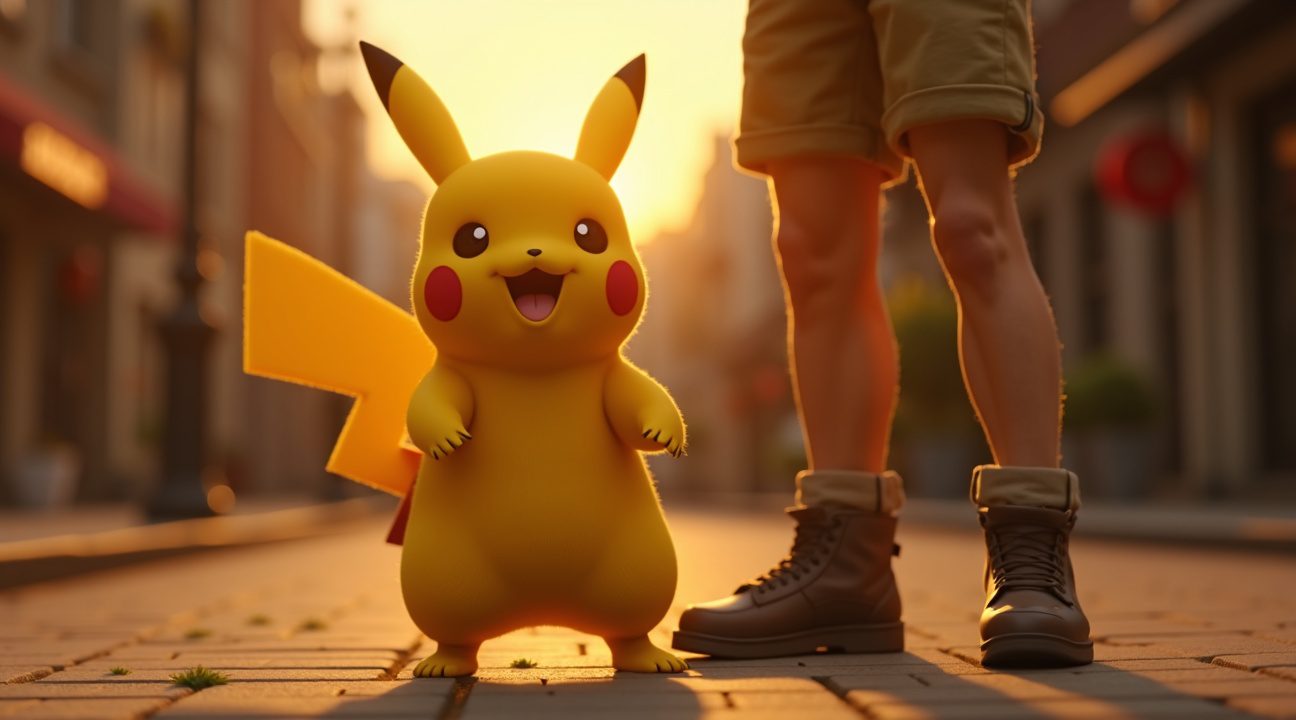
Ryan Reynolds’ Motion Capture Performance Brings Pikachu to Life
I find Reynolds’ transformation into Detective Pikachu one of the most impressive examples of how CGI made Pokemon possible in live-action cinema. His facial performance became the foundation for Pikachu’s emotional depth through an intricate motion capture process that used tracking dots to record every subtle expression.
The technology captured Reynolds’ micro-expressions, translating his natural charisma and comedic timing directly onto Pikachu’s yellow fur. Animators received raw data showing how his eyebrows raised during surprise, how his mouth curved during sarcastic quips, and how his eyes narrowed during moments of suspicion. This data proved invaluable for creating a character that felt genuinely connected to Reynolds’ personality while maintaining Pikachu’s iconic appearance.
Blending Human Expression with Pokemon Physicality
Animators faced the challenge of taking Reynolds’ human expressions and adapting them for a creature with completely different facial proportions and anatomy. They refined each captured performance to match Pikachu’s distinct personality traits, ensuring the character remained true to his Pokemon origins while benefiting from Reynolds’ natural expressiveness.
The animation team studied the following elements to perfect this balance:
- Pikachu’s large eyes required amplified emotional cues compared to human expressions
- Electric cheek pouches needed subtle animation to react with mood changes
- Ear movements became crucial for conveying attention and emotional states
- Body language incorporated both human gestures and rodent-like behaviors
Characters like Mr. Mime presented even greater complexity in motion capture translation. The production team organized physical workshops with professional mime artists to establish movement guidelines that would feel authentic yet entertaining. These sessions helped animators understand the precise body mechanics needed to make Mr. Mime’s performance feel both comedic and slightly unsettling.
The motion studies for supporting Pokemon characters went beyond traditional capture techniques. Animators observed real animals to understand natural movement patterns, then layered these observations with the captured human performances. This approach created characters that moved with biological authenticity while maintaining the expressiveness needed for compelling storytelling.
Reynolds’ improvisational style added unexpected challenges and benefits to the animation process. His tendency to deliver multiple takes with different emotional approaches gave animators various performance options to choose from. Sometimes they combined elements from different takes to create the perfect blend of humor and heart for specific scenes.
The success of this motion capture approach in Detective Pikachu 2 discussions shows how the technique established new standards for bringing animated characters into live-action environments. The seamless integration of Reynolds’ performance with Pikachu’s design proves that motion capture technology can preserve an actor’s essence while transforming them into completely different creatures.
This technological achievement extends beyond individual character creation. The lessons learned from Reynolds’ Pikachu performance influenced how other productions approach similar challenges. Future live-action Pokemon series will likely build upon these motion capture innovations, creating even more sophisticated character performances that bridge the gap between human actors and animated creatures.
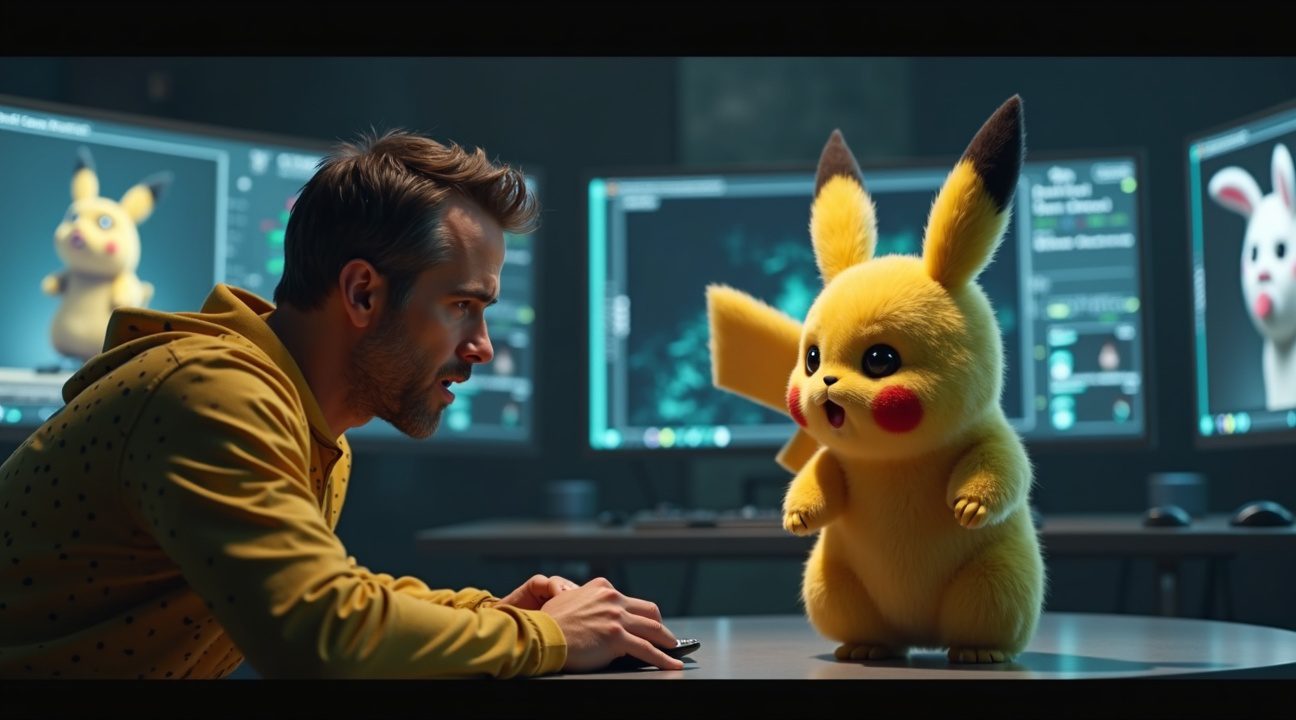
Real-World Animal Textures and Environmental Lighting Create Tactile Realism
CGI artists transformed beloved cartoon characters into believable creatures by studying actual animals for texture inspiration. Charizard’s skin received a leathery quality reminiscent of large reptiles, while Bulbasaur’s surface borrowed characteristics from amphibians to create that distinctive, slightly moist appearance. Pikachu’s CGI evolution proved particularly challenging, as artists needed to balance the character’s iconic yellow color with realistic fur properties that would move and catch light naturally.
The texture creation process relied on high-resolution scans and detailed concept art to achieve unprecedented levels of detail. Artists captured subtle surface qualities that make each Pokemon species unique – the glossy sheen in their eyes, feathery textures on bird-type creatures, and metallic surfaces on steel-types. These elements weren’t simply painted onto 3D models; they were built into the material properties themselves, allowing them to respond to light and movement in authentic ways.
Environmental Lighting Techniques
Lighting integration presented another significant challenge that required precise calibration between digital and practical elements. Artists used several key techniques to achieve seamless blending:
- Reference photography captured actual lighting conditions on set
- Texture balls placed in scenes recorded how light behaves across different surfaces
- Model sheets documented exact color temperatures and shadow angles
- Reflection mapping ensured Pokemon eyes and surfaces caught environmental details accurately
I’ve observed how this attention to lighting detail allows digital Pokemon to cast shadows that perfectly match their surroundings. When Pikachu runs across Detective Pikachu’s desk, the fur catches overhead fluorescent lighting exactly as real fur would. Subsequent Pokemon projects continue building on these foundational techniques.
The combination of animal-inspired textures and environmental lighting creates what I call “tactile believability” – viewers instinctively feel they could reach out and touch these creatures. This effect requires both technical precision and artistic intuition, as artists must balance realistic animal textures with the fantastical nature of Pokemon designs. The result transforms flat cartoon designs into three-dimensional beings that feel like they belong in our world, complete with weight, presence, and physical authenticity.
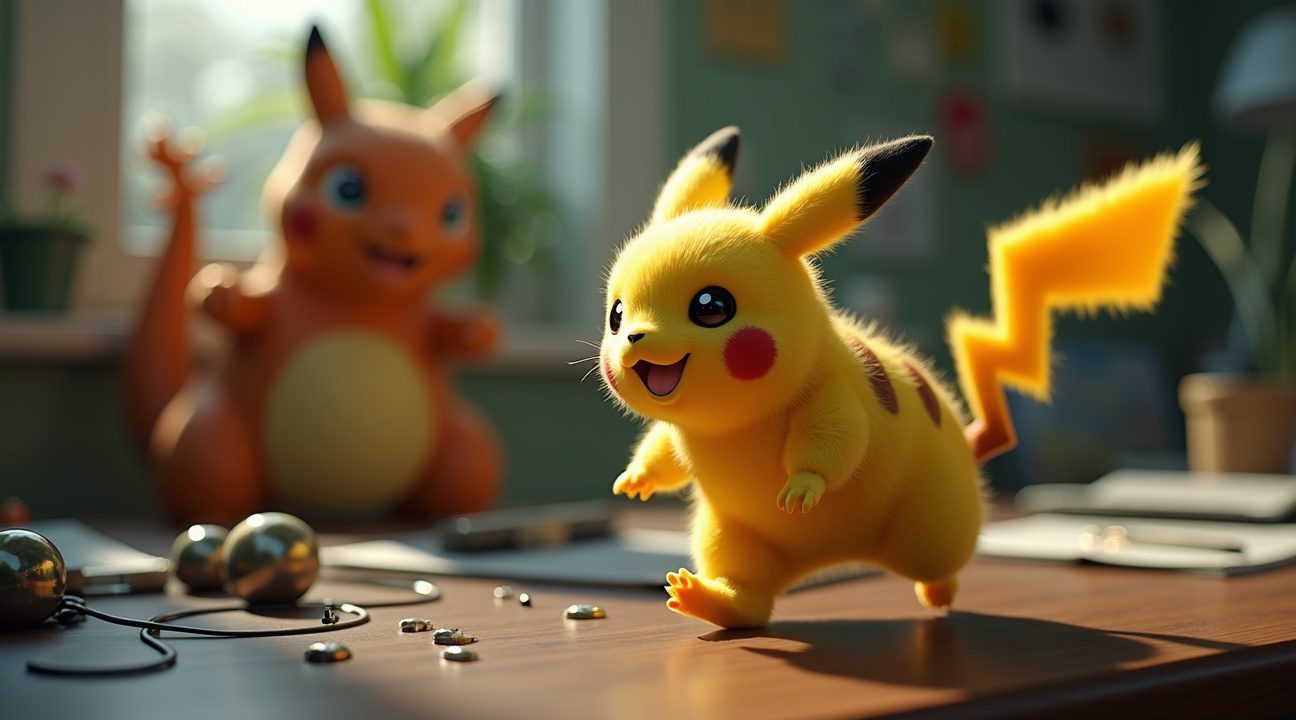
Puppet Stand-Ins and Location Filming Bridge Digital and Physical Worlds
On-set puppet ‘stand-ins’ served as crucial connectors between physical and digital production phases. These specially crafted stuffed versions of Pokemon gave actors essential eyelines and physical references, eliminating the guesswork that typically plagues interactions with invisible digital characters. Production teams recognized that actors needed tangible objects to create believable performances with their Pokemon co-stars.
Hero ‘stuffies’ represented the pinnacle of this practical approach, featuring realistic fur textures and glass eyes that accurately captured lighting conditions. These detailed puppets allowed cinematographers to observe how light would naturally fall across Pokemon features, creating reference points for CGI integration. Textured ‘fur balls’ and comprehensive 360-degree set photographs captured environmental information that proved invaluable during post-production work.
Real-world locations formed another cornerstone of authentic Pokemon integration. Filming in London and Scotland instead of relying entirely on digital environments helped Pokemon appear naturally embedded within human environments. This strategic choice eliminated the artificial feeling that often accompanies heavily digital productions, making creatures feel like genuine inhabitants of familiar settings.
Pre-visualization and Studio Collaboration
Large-scale Pokemon scenes demanded systematic pre-visualization to assign specific spaces within shots before adding digital characters. This planning phase prevented overcrowding and ensured each Pokemon had appropriate screen presence. Major visual effects studios tackled different aspects of the massive undertaking:
- MPC (Moving Picture Company) handled primary character animation
- Framestore focused on environmental integration and effects
- Image Engine contributed specialized digital creature work
VFX supervisor Erik Nordby coordinated these efforts, ensuring consistent quality across all partner studios. Animation teams relied heavily on official model sheets, concept art, and detailed reference materials called ‘settei’ to maintain accuracy with established Pokemon designs.
Collaborative feedback with The Pokemon Company guaranteed brand-faithful results throughout production. This partnership proved essential but time-consuming, as revisions required extensive back-and-forth communication between directors, VFX teams, and official Pokemon licensors. Sometimes single Pokemon characters underwent dozens of iterations before receiving final approval, demonstrating the commitment to authenticity that made the Detective Pikachu movie successful.
Each creature’s look and motion faced scrutiny from multiple stakeholders, ensuring that decades of Pokemon legacy translated seamlessly into live-action format. This collaborative approach, while demanding, produced results that honored the beloved franchise while pushing technical boundaries in creature animation and integration.
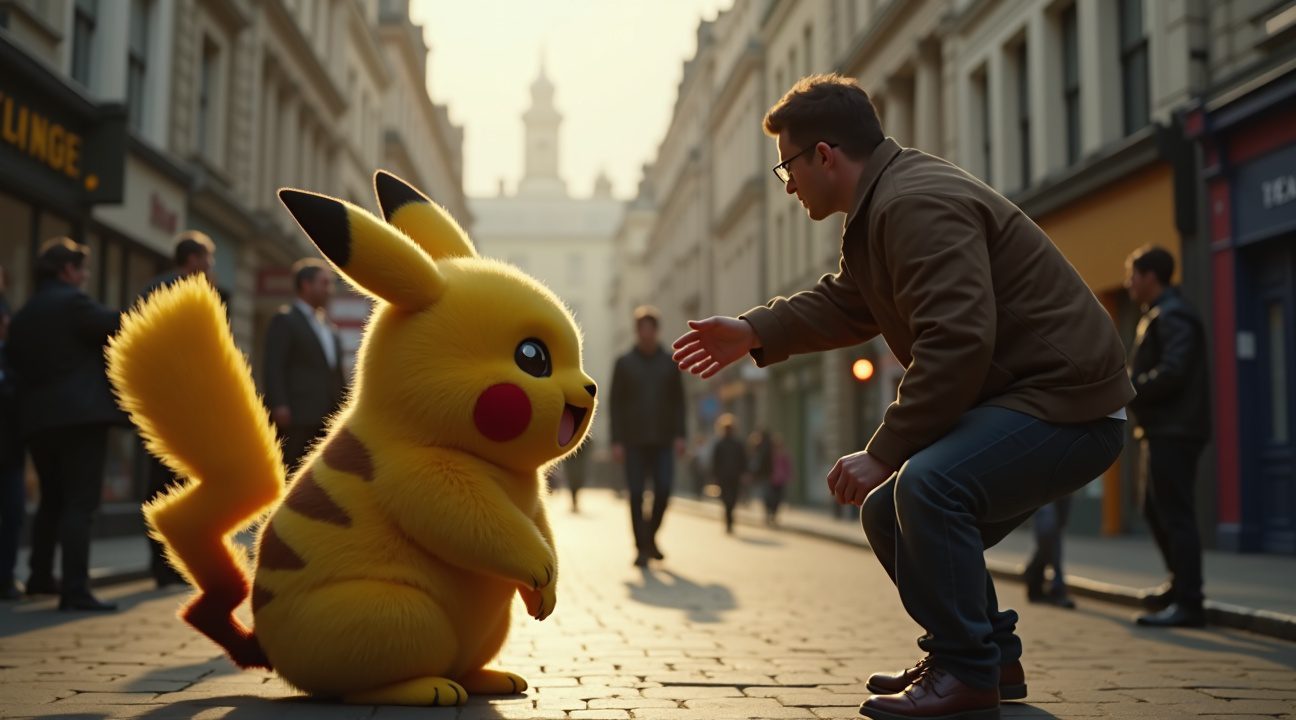
Sources:
The Pokemon Company
MPC (Moving Picture Company)
Framestore
Image Engine
VFX Supervisor Erik Nordby

